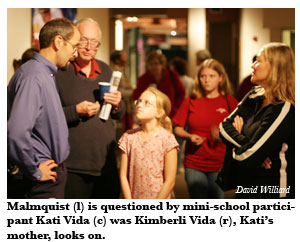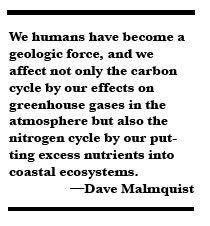Do not give up on the environment
 We cannot put the equivalent of 875 million
adult elephants per year into the atmosphere without changing the
climatic balance. That was the gist of an argument used by Dave
Malmquist, director of communications at the Virginia Institute of
Marine Science (VIMS), to illustrate the number of pounds of CO2 being
emitted into the atmosphere each year as he delivered his lecture,
“Global Warming: It’s Not Just Hot Air,” during the opening session of
the “Global Warming in the Chesapeake Bay” minischool at the Science
Museum of Virginia. CO2, he explained, is one of the greenhouse gases
that has driven up global temperatures by nearly 1 degree Fahrenheit
during the past decade.
We cannot put the equivalent of 875 million
adult elephants per year into the atmosphere without changing the
climatic balance. That was the gist of an argument used by Dave
Malmquist, director of communications at the Virginia Institute of
Marine Science (VIMS), to illustrate the number of pounds of CO2 being
emitted into the atmosphere each year as he delivered his lecture,
“Global Warming: It’s Not Just Hot Air,” during the opening session of
the “Global Warming in the Chesapeake Bay” minischool at the Science
Museum of Virginia. CO2, he explained, is one of the greenhouse gases
that has driven up global temperatures by nearly 1 degree Fahrenheit
during the past decade.“Since the beginning of the Industrial Age, we have put the equivalent of 28 billion elephants in carbon into the air,” he said.
Malmquist’s lecture, however, was about more than CO2 and its impact on global warming; it was an attempt to create an overview of human-induced changes that are contributing to the general degradation of the global environment and to specific effects on the Chesapeake Bay.
“The point I was trying to make is that global warming gets a lot of press, and everybody is focused on carbon in the atmosphere, but I think there is an issue of similar importance that is taking place in coastal waters that is not as well-recognized,” Malmquist said in an interview about the public course. “We humans have become a geologic force, and we affect not only the carbon cycle by our effects on greenhouse gases in the atmosphere but also the nitrogen cycle by our putting excess nutrients into coastal ecosystems.”
In terms of the Chesapeake Bay, the results, he said, are evidenced in expanding “dead zones,” in a vast reduction of sea grasses and in increased stresses on the estuary’s dominant species, including striped bass and blue crabs.
 Malmquist
admitted that much uncertainty exists when using scientific data to
predict future impacts of unabated and perhaps increased use of fossil
fuels and nitrogen-laden fertilizers that are the source of much
environmental damage, but it is undisputed that the earth’s surface
temperatures and sea levels are rising globally, he said. Given those
two facts and the potential for entering an irreversible downslide, he
encouraged members of his audience to continue taking measures to abate
their personal impact on the bay.
Malmquist
admitted that much uncertainty exists when using scientific data to
predict future impacts of unabated and perhaps increased use of fossil
fuels and nitrogen-laden fertilizers that are the source of much
environmental damage, but it is undisputed that the earth’s surface
temperatures and sea levels are rising globally, he said. Given those
two facts and the potential for entering an irreversible downslide, he
encouraged members of his audience to continue taking measures to abate
their personal impact on the bay.“I would say there are definitely things everyone can do,” he said. “I look at it as a win-win situation. Changes that would improve the quality of our lives, such as using energy-efficient appliances, having a lawn that doesn’t require addition of fertilizers or just moving closer to work, have the added benefit of helping to mitigate climate change.”
He said it was not time to be panicked but it certainly was time to be concerned. “If we are concerned, it means we will do something about it,” he said.
Malmquist was one of four speakers featured during the monthlong course at the museum. The others were John Boon III, professor emeritus at VIMS, Kenneth Moore, professor at VIMS, and Paula Jasinski, head of the National Oceanic and Atmospheric Administration’s (NOAA) Chesapeake Bay office.
Boon, an expert in tides and tidal surges, concentrated his presentation on two storms that caused devastation in the Chesapeake region, the “Storm King” of August 1933 and Hurricane Isabel of September 2003. The first, which he called the poster boy of hurricanes, produced the highest water level recorded in the region. It was used to identify the 100-year flood plain, the area that could be flooded during a major storm that can be expcted to occur once every 100 years. A Category 3 hurricane, its storm surge was measured at 5.8 feet. Although Isabel was a Category 1 hurricane, with a significantly smaller storm surge as it entered the bay, it caused water to rise to the same level, Boon said. The reason, he explained, was that the sea level had risen by nearly one foot during the 70 years between the two storms. The potential consequences for people living along the bay’s 10,000 miles of shoreline are obvious, he said. “All those people will be more vulnerable as time goes on.”
The rise in sea level is occuring in two ways, Boon said. One is thermal expansion. “As you heat the upper layers of the ocean, they expand,” he said. He estimated that if the temperature of the top 200 meters of the water column in the ocean rises by 1 degree Celsius, the rise in water level would measure between 20 and 20 millimeters. “That’s going on,” he said. “That’s increasing the volume of the oceans without increasing the mass.” In addition, he said, the mass of the oceans is increasing as glaciers melt. Contributing to the consequences for the coastal regions is that it is natural along the passive margin of a continental plate for the land to sink.
“It is coming to the point now where people are noting that the way the heat is distributed in the overall atmosphere is impacting the oceans. We don’t want to panic, but we should be very concerned.”
Boon says that he finds it perplexing that engineers who are planning projects in areas along the bay and along other shorelines are not taking into account the rising levels of the oceans. He questioned those who planned for a new boardwalk in Virginia Beach whether they had considered the fact that the sea was rising. “They said, ‘No.’ I thought, ‘Oh, brother,’” he said. He called the devastation caused by Hurricane Katrina in New Orleans, where the water level is rising at an estimated 3 feet per century, a “wake-up call.” Referring to a news show aired by the Public Broadcasting System on which engineers working to rebuild a dike were asked if they had taken sea-level rise into account, Boon said the engineers could only respond, “We’re going to build it better than ever.”
“The take-home message I was trying to get across at the minischool was that we certainly have things to think about if we live along the coast,” Boon said. “We took a terrible pounding from Katrina. I wonder if those lessons will be the long-lasting kind or if we will just forget them.”
Moore equated the loss of sea grasses in the bay—a recent estimate suggested that they were only at 15 percent of their historic distribution—with global warming. Noting that the past decade was the warmest in recorded history, Boon explained that sea grasses, particularly the eelgrass that grows along the shorelines in the bay’s saltier areas, was a temperate species that in the bay was at the southern limit of its range. “When we talk about global warming, we’re talking about extinction of species at the limits of their ranges, which is what we may be seeing in the Chesapeake,” he said. Another factor, he suggested, resulted from runoff from increasingly developed areas in the watershed, which clouds the bay and deprives the grasses of sunlight. The grasses were abundant in the 1930s through the 1950s, a time when farms were being abandoned in the watershed. “After World War II, the grasses began a big decline, which we’ve related to runoff from increased development,” he said. “The problem is that these grasses serve a critical role for certain species, such as the blue crab, which use eelgrass in the lower bay as a nursery area.”
Moore said that although it may seem that our individual efforts to combat global climate change have little effect, it is essential that we pursue them.
“Perturbations that you might consider natural interact with what you might consider man-caused impacts, such as turbidity and nutrients, in a negative way, so we should redouble our efforts where we can,” he said. “Because sea grasses are good indicators of the state of our estuary systems, their decline is something we definitely should take note of.”
Whereas the presentations by Boon and Moore included hard data based on their years of ongoing investigations, Jasinski concentrated her remarks on encouraging members of the audience to continue to take small, environmentally friendly steps.
“There are a lot of things the average person can do, and it is not just good for water quality but also can help stave off the global warming crisis,” she said. Among her recommendations were changing lightbulbs from the incandescent variety to the fluorescent kind, using rain barrels to collect rooftop water to water plants, setting thermostats down by 2 degrees in the summer and recycling old cars and old batteries.
“People need to take more responsibility for where they live and understand that they’re not living in a bubble,” she said. “Everybody lives in the environment together. Your mind-set cannot be that you can continue to pollute it.”
Jasinski explained that for her the battle is very personal. She recalled growing up on the Northern Neck of Virginia. “We took it for granted that we could go out and catch fish and catch crabs, and we could eat them,” she said. “My children can’t do that right now. That’s a huge concern to me; it should be a huge concern to anybody who is thinking about carrying on the next generation. What do we leave to them? If we have the mind-set that the environment is degrading and there is nothing we can do, that is giving up. Whatever we do, we cannot give up,” she said.
 Skip to main content
Skip to main content
